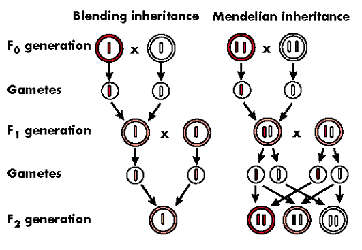What is the "Particulate Hypothesis of Inheritance" and "Blending Hypothesis of Inheritance" in genetics?
1 Answer
These are two different hypotheses about how genetic material is passed from parent to offspring.
Explanation:
In the bending hypothesis, if you have two parents who produce an offspring, the offspring has genetic traits that are a blend or combination of those two traits. Imagine if you put an eggplant and a cucumber into a blender. The eggplant is one parent's genetic material and the cucumber the other. The offspring would have a literal bend of eggplant and cucumber.
In the particulate hypothesis, the parents have separate genetic material (Mendel called them discrete particles and we now know them as genes ). These genes are passed onto offspring and remain in the offspring even if not expressed. The eggplant parent and the cucumber parent have an offspring that has the eggplant genetic material or the cucumber. The two contributions remain distinct entities.
Below, the Mendelian inheritance is another name for the particulate inheritance. With the particulate hypothesis, the offspring inherits one gene from each parent. In the example below, if the red allele is dominant, it would be the trait expressed in the F1 generation, yet the white allele from the other parent would still be present. This is not the case in the Blending inheritance model; both alleles mix to form pink and therefore neither distinct red or white allele is present in the upcoming offspring.
 https://www.studyblue.com/notes/note/n/exam-1/deck/5599067
https://www.studyblue.com/notes/note/n/exam-1/deck/5599067

